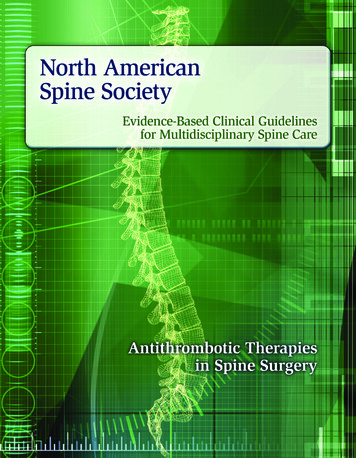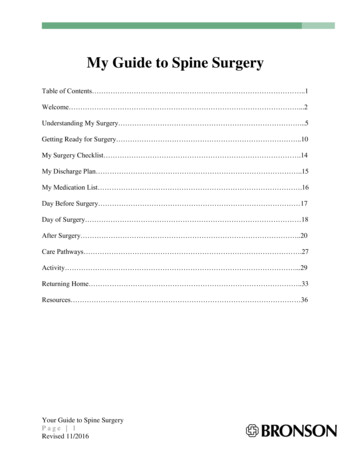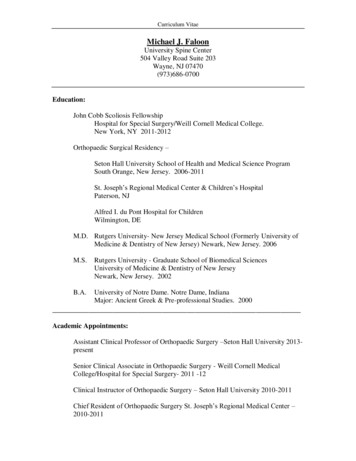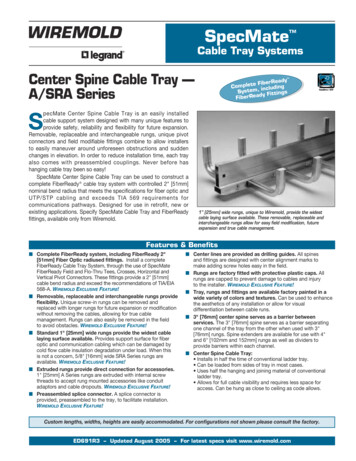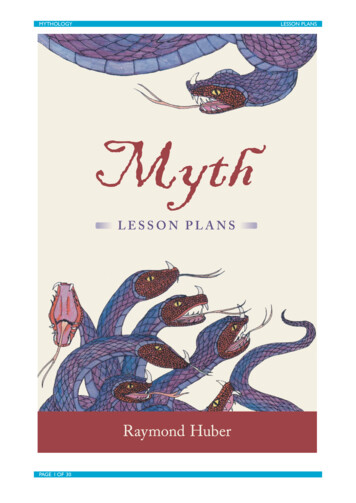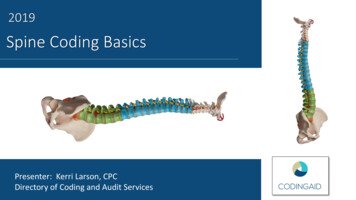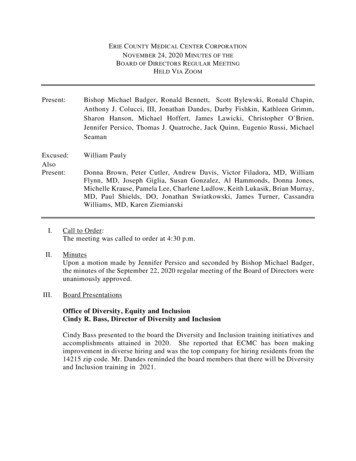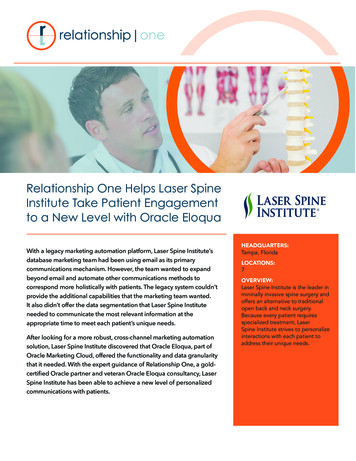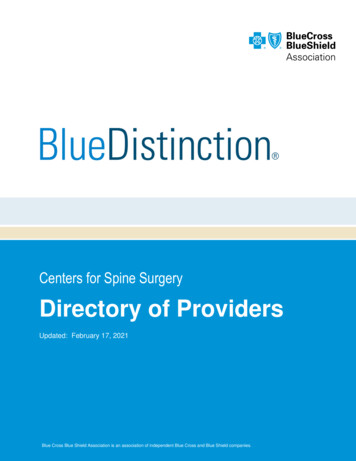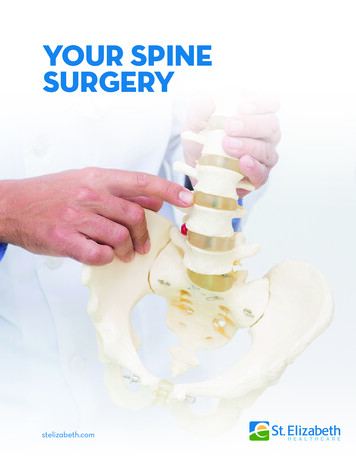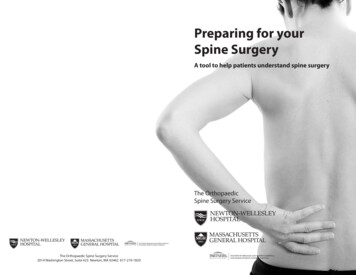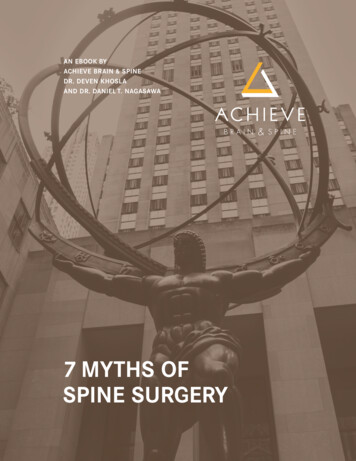
Transcription
AN EBOOK BYACHIEVE BRAIN & SPINEDR. DEVEN KHOSLAAND DR. DANIEL T. NAGASAWA7 MYTHS OFSPINE SURGERY
Table of ContentsINTRODUCTIONMYTH #1:I am going to be paralyzed unless surgery is done immediatelyMYTH #2:I have bulging disks in my neck or low back and need fusion surgeryMYTH #3:I will never be able to get back to doing things I loveMYTH #4:I am too old for surgery or I am too young for surgeryMYTH #5:Spine surgery is never successfulMYTH #6:Surgery is my only optionMYTH #7:I will be disabled from spine surgery andwill be in bed for months recoveringFR ONT COV E RIn Greek Mythology, Atlas was a Titan condemned to hold up the Earth/Heavens for all eternity.This visualization led to naming the first cervical vertebrae the Atlas, as it holds up the skull/brain above it.
IntroductionThe medical world can often seem overwhelming, and perhapsno aspect more so than the realm of neurological surgery.When confronted with disorders of the brain and spine, stakes are high.An individual’s entire quality of life may rely on a few criticaldecisions in treatment strategy. However, after seeking advice from theInternet, friends, and even healthcare professionals, we may still beleft with fear and confusion regarding, “What is the RIGHT thing to do?”In this eBook, we attempt to dispel common myths associatedwith spine surgery in hopes of bringing some clarity toyour options and alleviate some anxiety associated with your decision.Our team of Neurosurgical Experts are ready to help youAchieve the best outcomes possible.
MYTH #1:I am going to be paralyzed unlesssurgery is done immediately.This is most often in the setting of a person whohas neck problems where a cervical spine disk ispushing against the spinal cord.The short answer is that becoming paralyzed is an extremely unlikely event as mostspinal conditions have been slowly progressiveover years.In order to understand this further, weneed to know a little about the anatomy. Normally, the brain controls our motor and sensory function in the arms and legs by sending the signalsthrough the spinal cord. There are nerves thatleave the spine at each level (there are sevenneck vertebrae numbered C1-7 and disks fromC2 to C7).Normally, there is no pressure on the spinal cord or nerves. When people have a pinchednerve, they get symptoms referable to thatnerve’s function or distribution. For instance, theC6 nerve being damaged classically will affectthe bicep strength and also the hand sensationin the thumb and index finger. This is called cervical radiculopathy when a nerve is compressedfrom foraminal stenosis or a disk herniation.The foramen is the channel where the nerve exits and stenosis is when there is narrowing of achannel. Unless someone has loss of strengththat is sudden or is significantly impairing theirfunction, disk herniations causing isolated nervecompression will often resolve over time and inabout 80% of cases, the patient will not need surgery. Treatments are often directed to stretching,therapy, injections of steroids and considerationfor surgery if there is no response to these moreconservative treatment.Should the disk herniation or spinal canalstenosis be damaging the spinal cord, there is
concern that the patient could have permanentloss of function below the level of compression.This would be true in the setting of someonehaving spinal cord compression and swelling ofthe spinal cord. Also, there would be concernif someone had a fall or an accident and alreadyhad compression of the spinal canal. The whiplash movement could cause a sudden worseningand damage to their function. In these situations,the surgeon would diagnose the patient with cervical myelopathy and stenosis and recommendsurgery more urgently or immediately.A thorough evaluation and consultationwith your Neurosurgeon would answer the question of whether you will be paralyzed if you donot have surgery. However, this is often said andseldom true.At Achieve Brain and Spine, Dr. DevenKhosla and Dr. Daniel T. Nagasawa understandthat the decision for surgery is serious and willrecommend this option only when necessary.
MYTH #2:I have bulging discs in my neck or lowback and need fusion surgery.“Bulging” or “herniated” discs are relatively common occurrences. A recent analysis of the literature found that nearly 30% of people in their 20shave some degree of disc protrusion, increasingto 43% of those who are 80 years of age. However, none of these individuals had any symptoms.Similarly, nearly 40% of people in their 20s havesome evidence of disc degeneration, increasingto 96% of those in their 80s.[1]Just because you have “abnormal” MRIfindings, it does not necessarily mean that youneed surgery. The decision to pursue any surgical intervention for your spine should be madein careful collaboration with your surgeon afterdetailed discussions regarding your symptoms,physical exam, imaging findings, and goals foryour overall quality of life. However, for thosewho have significant symptoms severely affecting their daily activities that correspond to anassociated disc herniation, surgery may be necessary when conservative measures have beenexhausted.It is estimated that approximately 1-3%of the population are symptomatic from theirlumbar (low back) disc herniation, with the greatest prevalence being among males aged 30-50.Those at increased risk include individuals whosmoke, engage in weight-bearing sports, or areinvolved in activities with repeated lifting.[2,3]Despite overall rapidly increasing ratesof spinal fusions, most cases of lumbar disc herniations can be treated with microdiscectomiesalone (WITHOUT FUSION) in order to releasethe pressure on the nerves and relieve radicular (shooting leg) pain. During this procedure, asmall portion of the bone is drilled and only theloose herniated disc is removed, thus reducingthe compression on the affected nerve. A fusionprocedure is typically reserved for deformitycorrection (scoliosis) or situations in which the*L4/5 LUMBAR DISC HERNIATION
*SCOLIOSIS/DEFORMITY CORRECTIONspine is determined to be mechanically “unstable,” requiring additional intervention to fix theimproper alignment or abnormal movement.[4]For those who have a herniated disc inthe cervical spine (neck) and have significantsymptoms associated with it, a fusion MAY benecessary depending upon the patient presentation and anatomy. The most common procedures to address a herniated disc of the cervicalspine include: Anterior Cervical Discectomy andFusion (ACDF; removing the disc herniation fromthe front of the neck and fusing the level above/below to stabilize the spine), Artificial Disc Re-*FUSION FOR INSTABILITY/ SPONDYLOLISTHESISplacement (ADR; removing the disc herniationfrom the front of the neck and replacing it withan artificial disc- NO FUSION),Posterior Cervical Laminectomy (decompressing the spine from the back of the neck bydrilling off some bone to release the pressure onthe spinal cord/ nerves — NO FUSION), or Posterior Cervical Laminectomy with Fusion (same asthe laminectomy, but adding a fusion of two ormore levels to stabilize the spine). The decisionon which procedure is right for you depends ona number of factors, and should be made aftercareful discussion with your surgeon.
*ANTERIOR CERVICAL APPROACH*ACDF*ADR*POSTERIOR CERVICAL LAMINECTOMY*POSTERIOR CERVICAL LAMINECTOMY/FUSION
MYTH #3:I will never be able to get backto doing things I love.When someone has a disease that strikes at theheart of their quality of life and even sitting, bending, standing and walking are tasks that becomechallenging or impossible, it can be life altering!As physicians, we do see how this can lead tofeelings of depression and affect relationships athome and work. Inability to work creates financial stressors on people and we understand thisvicious cycle needs to be broken.For those who are athletes, often theiridentity and daily schedules revolve around theiractive lifestyle. Getting back to their sport isimportant and with the right guidance, it is thenorm rather than the exception.With or without surgery, the ability to helpyou get back to doing things you love to do andneed to do exists. Recent advances in the field ofNeurosurgery have been staggering. From minimally invasive techniques to correction of scoliosis to removal of cancerous tumors of the spine,the technology available has revolutionized howwe do surgery. Techniques like artificial disk replacement allow for maintenance of movementwhere in the past the only option was -treatment/total-disc-replacement/#vm A 57a013f4From the advanced imaging we use to visualize the nervous system and how it relates tothe bony anatomy, Neurosurgeons can develop aplan to help the patient. We have a unique understanding of the nervous system and correlate theneurological symptoms and examination findings with the imaging prior to making any recommendations. Utilization of a team approachwith physical therapists, pain and rehabilitationspecialists, and collaboration with regenerativemedicine providers is employed to maximize thechance of avoiding surgery.At Achieve Brain and Spine, we start bylistening to the patient and understanding howtheir life has changed and help patients achievemaximal recovery, often regaining neurologicalfunction that would have been not possible inyears past.
MYTH #4:I am too old for surgery or I amtoo young for surgery.While no one typically wants to have surgery,there comes a time when a threshold is surpassed and quality of life is simply too unbearable to continue without it. Yet how should ageplay a factor in your decision?In the United States, there are morethan 45 million people over the age of 65. By2030, 20% of our population (72 million) is anticipated to be over 65 years old.[5] A recentanalysis from England found that nearly 23%of their population aged 75 years or older wereundergoing surgical procedures, a 6% increasefrom 15 years prior.[6] As our global populationages, so too will their need for surgical interventions to be conducted in a safe manner. However, age itself is an inadequate measurement ofa patient’s health or ability to tolerate a surgicalprocedure; not all patients with the same agehave the same risks. Instead, “frailty” has beensuggested as a better predictor for post-operative complications.One model describes frailty in termsof body mass, strength, endurance, balance,walking performance, and activity level. Another assessment describes an accumulation ofdeficits: medical issues, physical/cognitive impairments, psychological and social risk factors,and common geriatric syndromes.[7]Regardless of your age, a critical aspectof your decision to proceed with surgery shouldbe adequate preoperative work-up and optimization of any medical conditions you may have.This will allow you to gain an accurate understanding of your peri-operative risks associatedwith the procedure (e.g., heart attack, stroke,blood clots, etc.) and make a truly informeddecision as to whether or not you would like toproceed. For patients with a strong surgical indication who are young and healthy, this may bethe best time to have surgery, as you may neverbe more able to tolerate an operation than thepresent.
MYTH #5:Spine surgery is never successful.Sometimes surgery is not successful and as with any surgery, complications are possible. When that happens, people have issues with prolonged recovery and sometimeshave trouble with healing properly.More importantly, expectations from surgery are important to discuss with thedoctor. Physicians and patients have to spend time with one another and discuss allaspects of their recovery as well as risks from surgery.If expectations of the patient are not realistic or not discussed with the surgeon, then they will often feel that surgery was not successful. Communication is soimportant in getting this right and cannot be over emphasized.With realistic expectations and a shared decision-making model that includesthe patient, family and physician, there is every reason to expect a successful surgery.Patient reviews and stories highlight our ability to partner in your care andguide you through this challenging time.Please visit this page for these /patient-stories/
MYTH #6:Surgery is my only option.*EPIDURAL STEROID INJECTIONSSURGERY IS NEVER THE ONLY OPTION!While there are many circumstanceswhere surgery can be the best option, patientsshould never be pressured or obligated to feel asif it they have no choice on how their health ismanaged. Know that you ALWAYS have options,with conservative management at one end ofthe spectrum and potentially surgery at the other. Examples of conservative management mayinclude medications (opiates, anti-inflammatory medications, oral steroids, muscle relaxants,“nerve medications,” etc.), physical therapy,acupuncture, chiropractic interventions, yoga,pilates, aquatherapy, injections (epidural, facet,trigger-point, sacroiliac joint, etc.), bracing, radiofrequency ablation, and many others.[8]For those with a lumbar (low back) discherniation and associated radicular (shootingleg) pain, the vast majority (70-90%) are able toimprove within a year seeking conservative management alone. This alleviation of symptoms is aresult of reabsorption/regression of the herniated disc with time. Trials suggest that regardlessof treatment strategy (surgery or conservative),most patients improve; although, surgical patients simply improve faster.[2, 8, 9] However, forthose that have exhausted conservative management and are still in severe pain affectingtheir quality of life, surgery may be a strongerconsideration. Other strong indications for moreurgent surgery would be new onset weakness,bowel or bladder incontinence, or peri-anal/genital numbness. Yet no matter what the situation,know that you, the patient, always have options.
MYTH #7:I will be disabled from spine surgeryand will be in bed for months recovering.This could not be further from the truth. We usually encourage early mobilization on thesame day after surgery. Advances implemented such as the ERAS (Enhanced RecoverAfter Surgery) protocol help patients spend minimal time in the hospital.In fact, some surgeries are done in an outpatient setting and patients can expectto resume a relatively normal lifestyle within 2-8 weeks depending on the type of surgeryand the demanads on their bodies from work. Individual factors are also important andthe patient’s weight, tobacco/nicotine use, and medical history (especially diabetes andhypertension) are variables that can affect the speed of recovery and length of stay inthe hospital.We want to achieve the best possible outcome from your particular surgery andwith our extensive experience, scientific knowledge, and access to the latest technology, it is our expectation that you will be independent and feeling the positive effects ofsurgery.
REFERENCES1.Brinjikji, W., et al., Systematic literature review of imaging features of spinal degenerationin asymptomatic populations. AJNR Am J Neuroradiol, 2015. 36(4): p. 811-6.2.Jordan, J., K. Konstantinou, and J. O’Dowd, Herniated lumbar disc. BMJ Clin Evid, 2009.2009.3.Dulebohn, S.C., R. Ngnitewe Massa, and F.B. Mesfin, Disc Herniation, in StatPearls. 2019:Treasure Island (FL).4.Martin, B.I., et al., Trends in Lumbar Fusion Procedure Rates and Associated HospitalCosts for Degenerative Spinal Diseases in the United States, 2004 to 2015. Spine (PhilaPa 1976), 2019. 44(5): p. 369-376.5.Sade, R.M., The graying of America: challenges and controversies. J Law Med Ethics,2012. 40(1): p. 6-9.6.Fowler, A.J., et al., Age of patients undergoing surgery. Br J Surg, 2019. 106(8): p. 10121018.7.Lin, H.S., et al., Frailty and post-operative outcomes in older surgical patients: asystematic review. BMC Geriatr, 2016. 16(1): p. 157.8.Weinstein, J.N., et al., Surgical vs nonoperative treatment for lumbar disk herniation: theSpine Patient Outcomes Research Trial (SPORT): a randomized trial. JAMA, 2006. 296(20):p. 2441-50.9.Jacobs, W.C., et al., Surgery versus conservative management of sciatica due to a lumbarherniated disc: a systematic review. Eur Spine J, 2011. 20(4): p. 513-22.
ConclusionWe hope that you were able to gain some valuable insight regarding spine disorders andcommon management strategies to treat them. We understand that spine disease canbe an extremely painful, debilitating condition requiring urgent attention. As such, we areavailable to see you as quickly as possible to help guide you along your journey to recovery.We promise to treat each patient with dignity and respect, to educate you about the diseaseprocess and progression, and listen to your story so that together, we can Achieve the bestquality of life possible for you via conservative or surgical interventions.Deven Khosla, MD, Deven Khosla, MD, Board Certified Neurosurgeon has an extraordinary level of experience in spinal surgeryand neurosurgery. He is the founder of Achieve Brain and Spine andhas been taking care of patients since 2001. He is part of the localcommunity is committed to help people of all walks of life in aninclusive, welcoming environment. From minimally invasive procedures such as artificial disk replacement to complex spine deformitycorrections to brain tumor surgery, Dr. Khosla’s care for his patientsis his primary focus.Daniel T. Nagasawa, MD, Fellowship Trained Spinal Neurosurgeonwho did his residency training at world-renowned UCLA, andcompleted specialization fellowship in Advanced Techniques forComplex Spinal Surgery at Kaiser LAMC. He credits love for hisfamily as the core of his strength, and treats every patient the sameas he would any of them. Dr. Nagasawa is the co-founder of AchieveBrain & Spine.Schedule a ConsultationPhone: (310) 710-1919achievebrainandspine.com2811 Wilshire Blvd., Suite 930Santa Monica, CA 90403INSURANCE & FINANCING All insurance policies are acceptedat Achieve Brain & Spine Santa Monica, Culver City and LosAngeles, and we offer our patients financing options. Please calltoday to learn more about our advanced, cutting-edge treatments,and to arrange an in-person consultation. Our friendly, helpfulstaff can assist you with questions about insurance or financing.
(310) 710-1919achievebrainandspine.com
Spine surgery is never successful. Sometimes surgery is not successful and as with any surgery, complications are pos-sible. When that happens, people have issues with prolonged recovery and sometimes have trouble with healing properly. More importantly, expectations from surgery are important to discuss with the doctor.

